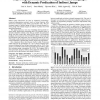Free Online Productivity Tools
i2Speak
i2Symbol
i2OCR
iTex2Img
iWeb2Print
iWeb2Shot
i2Type
iPdf2Split
iPdf2Merge
i2Bopomofo
i2Arabic
i2Style
i2Image
i2PDF
iLatex2Rtf
Sci2ools
108
click to vote
ASPLOS
2008
ACM
2008
ACM
Improving the performance of object-oriented languages with dynamic predication of indirect jumps
Indirect jump instructions are used to implement increasinglycommon programming constructs such as virtual function calls, switch-case statements, jump tables, and interface calls. The performance impact of indirect jumps is likely to increase because indirect jumps with multiple targets are difficult to predict even with specialized hardware. This paper proposes a new way of handling hard-to-predict indirect jumps: dynamically predicating them. The compiler (static or dynamic) identifies indirect jumps that are suitable for predication along with their control-flow merge (CFM) points. The hardware predicates the instructions between different targets of the jump and its CFM point if the jump turns out to be hard-to-predict at run time. If the jump would actually have been mispredicted, its dynamic predication eliminates a pipeline flush, thereby improving performance. Our evaluations show that Dynamic Indirect jump Predication (DIP) improves the performance of a set of object-oriente...
ASPLOS 2008 | Indirect Jump | Indirect Jump Instructions | Indirect Jump Predication | Programming Languages |
| Added | 12 Oct 2010 |
| Updated | 12 Oct 2010 |
| Type | Conference |
| Year | 2008 |
| Where | ASPLOS |
| Authors | José A. Joao, Onur Mutlu, Hyesoon Kim, Rishi Agarwal, Yale N. Patt |
Comments (0)

